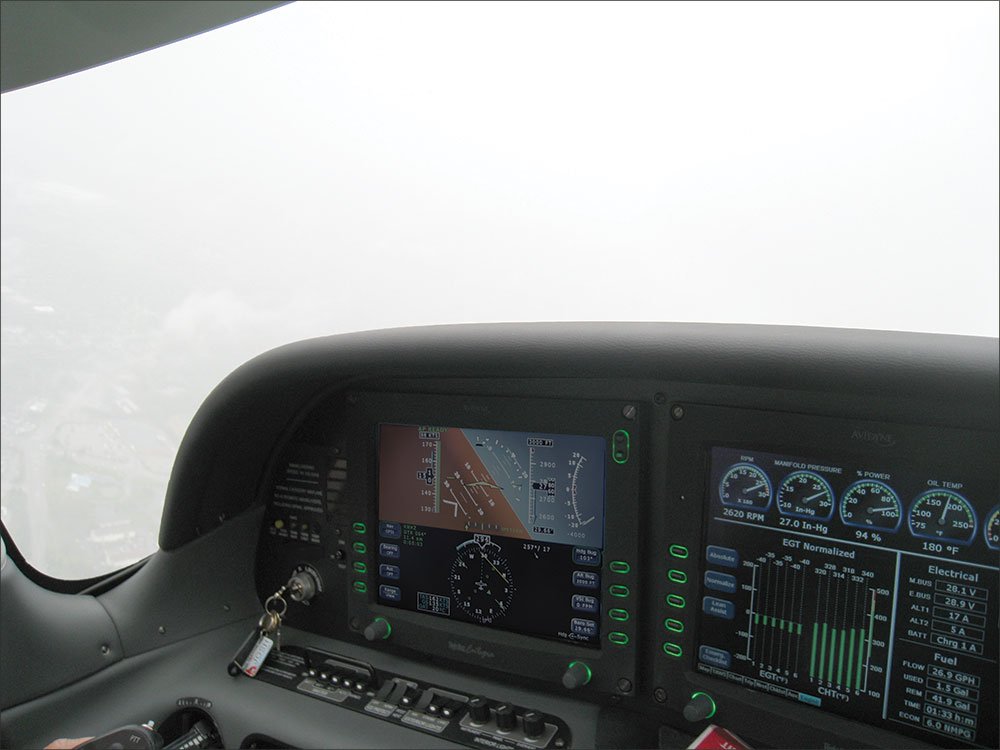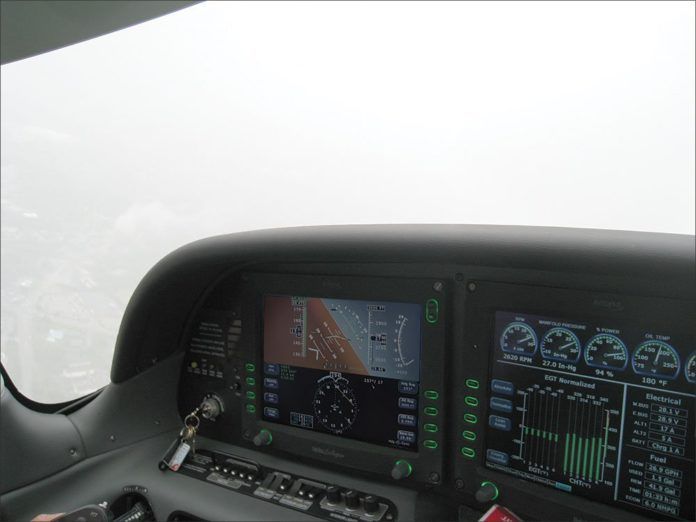We make a lot of noise about pilots busting minimums or botching departures, but the two heavy-hitting IMC killers we found were failure to climb and simply losing control.

Any activity that regularly kills between one half and one percent of its participants has room for improvement. Cutting the GA accident and death rate has been a cause celeb recently, and we heartily approve. Here at IFR, we decided to make our own contribution by delving into the accident rate specifically for IMC, focusing on where the outcomes were fatal.
Deadly IMC accidents aren’t hard to find. The preliminary 2011 Air Safety Foundation’s (ASF) Nall Report data shows that for non-commercial, fixed-wing accidents, which accounted for 83 percent of the accidents in 2011, only 16 percent of day VMC accidents are lethal. That number climbs to 21 percent for night VMC. IMC accident lethality is 59 and 71 percent day and night, respectively. The consequences for screwing up in the clouds are severe.
Our core question is: What’s the biggest killer?
Digging Through Numbers
To at least start this conversation, we looked at the past six years of accident data using the ASF accident database. This allowed us to pull NTSB records with keyword searches to identify factors and focus our study of IMC only. Details from several years of ASF Nall Reports also offered more insights.
Next we parsed out duplicates, because most accidents have multiple keywords, and then assigned a primary cause. This is highly subjective. For example, if you have a King Air that ducks down below minimums, attempts to circle and then loses control while trying to go missed, is that poor procedure, go-around, or spatial disorientation (SD)?
This means our numbers may vary from someone else (like the ASF) looking at the same data. But our goal isn’t to quibble over a percentile in this category or that; it’s to find the big-ticket items for further discussion.
Eventually we pared it down 199 accidents in IMC over six years, each having a single, primary factor assigned. These were ranked for both lethality (how high a percentage were fatal) and that category’s percentage of total accidents (see opposite page).
“Top Five” seemed to be the magic number on both lists. For lethality, the top five items were 100-percent deadly. These were: SD, drugs and alcohol, medical, instrument failure, and thunderstorms. But cumulatively, these accidents represented only 13 percent of the total accidents and 18 percent of all the fatal accidents. We need to guard against these issues, for sure; but even removing all of them would leave 82 percent of the body count untouched.
The top five categories in terms of frequency were VFR-into-IMC, IFR approach, SD, takeoff and climb, and landing. These represent 79 percent of the total accidents and 85 percent of the lethal ones. This is our quarry. We can focus tighter by eliminating landing accidents, which had zero-percent lethality in this data. We can also remove VFR-into-IMC for the moment, as we’re focusing on instrument pilots on IFR flight plans. While some of the VFR-into-IMC pilots were instrument-rated, they weren’t flying on instrument flight plans or even in instrument-capable aircraft.
That leaves approaches, SD and departures. And you’ll see that even within this group, SD extends its reach beyond its own category in surprising frequency.
Botched Approaches
The 2010 Nall Report shows three out of four accidents on approach in IMC turn out fatal. That’s in line with an average 72-percent lethality over six years we found. Nall points a finger at the classic duck-under: “The most consistently lethal category was improperly executed instrument approaches, usually involving descents below the published minimum altitude for a segment or descents below the minimum descent altitude or decision height without the required visual references.”
While we agree this is a big factor, our study points a bigger finger at something much more mundane: loss of control (LOC), probably due to SD.
Sometimes SD’s role is pretty clear. A Piper Malibu got some tough vectors that apparently led to the upset: “The vectors were close together and included a left 90-degree turn, a descent, and a 180-degree right turn back toward the localizer course. During the right turn and descent, the airplane continued turning with increasing bank and subsequently impacted the ground.”
Sometimes it’s tough to say. Radar showed a Cessna 310 left and right of the localizer inbound and poorly stabilized. During the end of the approach, the aircraft was slowing through 77 knots and descending 1500 FPM. Did they just drop through the bottom of the glideslope trying to get down or did they sink to terra firma in a flat attitude but would have stalled and spun in classic SD style had they been 500 feet higher?
To try and better understand how SD played into these accidents we still have in the approach category, we went back to just the approach accidents and tagged them with at least one contributing factor (see page 7).
Yes, the biggest procedural misstep was continued descent beyond the DA, MDA or MVA (in one case). It happened in 37 percent of the fatal accidents. But SD/LOC was a likely contributing factor in 52 percent of these accidents.
The most popular combination seems to be a low-altitude alert issued by ATC followed by an attempt to climb and/or rejoin the approach, and a subsequent loss of control. Some of these were painted right on ATC radar: alert issued, aircraft climbs, aircraft slows, and aircraft descends rapidly off radar.
It’s easy to see how this might happen. The pilot reaches MDA or approaches DA and turns too much attention outside the aircraft, searching in low visibility for the runway. The aircraft strays too low or off course and ATC calls. The pilot then looks back inside—but to the CDI or GPS to see why they are off course. Perhaps they also pitch up and start the climb, maybe adding appropriate power and cleaning up, but maybe not. Aircraft attitude gets attention too late.
This isn’t to say we didn’t find some appalling instances of procedure gone wrong. One Bonanza ended its approach to the non-towered airport by colliding with the airport’s perimeter fence, about 750-feet to the side of the runway. Follow procedures and this can’t happen. But get suckered into innocently spending too much time searching for the ground and you’ll find it, just not the exact piece of it you were looking for.
There were also some examples where we’ll never know how much each factor was causal. Take the example where ATC let a pilot down to the MVA for an airport with no approach and then cleared him for a visual with the airport in sight despite low visibility and darkness. But radar data shows that pilot was 400 feet lower than the MVA he’d been cleared to. Once he had clearance for the visual, he overflew the airport at 800 feet AGL and turned back for landing. He never made it.
We also found some instances where pilots perished because they apparently did nothing … when something immediate and aggressive was warranted. Take the Baron pilot who made a five-hour and 25-minute flight at night and then had to divert to an alternate in low weather. Tower at the alternate saw the pilot left of course and above glideslope and queried the pilot. When the pilot acknowledged he wasn’t established, Tower gave him heading and altitude for a missed.
He acknowledged but never turned or climbed, and subsequently crashed into a residential area about half a mile from the runway. Was this fatigue, disorientation or distraction? We can’t say.
But it’s clear that a killer factor in approaches gone wrong is simply losing control of the airplane.
Departure Disorientation
Accidents attributed primarily to SD are the next ones under our microscope, with seven percent of the total accidents and 100-percent lethality. Of these, four were cases where the pilots lost control en route or early on approach for no clear reason, and one more appears to be instrument failure inducing SD.
The remaining nine accidents—64 percent of the total SD accidents—were SD during takeoff and climb, or during a climb from VMC into IMC while en route. This isn’t counting another 14 accidents during takeoff that didn’t appear to be cases of SD, and isn’t including VFR-into-IMC accidents where pilots entered the clouds inadvertently and lost control.
That’s a disturbingly high number of pilots intentionally entering the clouds and then failing to maintain basic attitude instrument flying.
To be fair, one of these could be a case of instrument failure, but the fact that the pilot reported it right after entering the clouds makes it questionable whether it was the instruments or the pilot’s disbelief of what the instruments were saying. Then again, two fatal go-around crashes may have some aspect of SD in them as well, so the number may be a bit higher than we’re reporting here.
No matter what the exact count is, SD after entering IMC is a recurring theme. The accident sequence is often quick, as you can see in the summary of one Aero Commander: “Less than two minutes after the airplane departed the airport, the controller observed the airplane in a right turn and instructed the pilot to report his altitude. The pilot responded he thought he was at 3500 feet and he thought he had lost the gyros.” Maybe he did, but post-crash analysis and Occam’s razor point to simple disorientation.
A Cessna 310 had a similar tale: “The pilot departed from the airport under instrument meteorological conditions on an instrument flight rules flight plan. Weather included a 300-foot overcast cloud layer and one-mile visibility with light rain and mist. Shortly after takeoff, the air traffic controller lost radio contact with the pilot, and witnesses observed the airplane rolling under full power as it descended out of the clouds.”
These were experienced pilots of piston twins, so this isn’t just an accident for the novice or non-proficient. One of the other accident pilots in this group had an IPC days before the wreck.
Another recurring departure problem that surprised us with its prevalence is best described as a general failure to climb. One aircraft that departed in “calm winds, a 1/4-mile visibility in fog and a vertical visibility of 100 feet. Shortly after takeoff for the instrument-flight-rules flight, the airplane made a slight turn to the left and impacted the tops of 25-foot trees about a 1/2 mile from the runway.” Another accident had a similar summary: “After departing Runway 24, the airplane collided with the top conductor of a telephone line an estimated 2500 feet from the departure end of the runway. The estimated elevation of the line was 245 feet.”
If you’re thinking these were climb-challenged, overloaded aircraft, think again: They were both King Airs. Piston twins and singles were members of this group as well, again with experienced pilots. Perhaps that’s part of the problem: Entering the clouds is routine, so it’s easier to let your attention wander to other cockpit tasks and away from just maintaining a positive rate of climb.
Surprisingly lacking from the takeoff accidents are multiple examples of pilots who blithely ignored DPs and climbed on course into mountains. Departure procedures are perhaps the most under-studied aspect of instrument flying, and we regularly get letters about close calls and confusion on departures. But the accident record doesn’t show it.
What procedural accidents we saw were more mundane. A Cessna 182 that turned right on course, probably because the turn was shorter that way but unfortunately into higher terrain. A longer left turn would have been a climbing turn over the ocean. A Piper Arrow made a similar mistake turning away from weather on the climb out, but into forgotten terrain.
A Cessna 310 departing into near-zero-zero, may have made both the climb and the turn errors. He hit power poles half a mile from the runway after a 45-degree left turn after only climbing to about 50 feet AGL. The ODP is simple for his departure off Runway 31 he was using: “Turn right; all aircraft climb direct to the SJC VOR before proceeding on course.” The departure for Runway 13 is the same except for instructions to turn left. Did he accidently read the wrong one, or just wander off course as well as fail to climb?
Out of Control
The accident reports weren’t all about loss of orientation or situational awareness. We saw notable performances by structural icing, fuel mismanagement and mechanical problems. Two fatals in 2010 look like pilot hypoxia. As more go-high, go-far capability gets into piston singles, this may become more of an issue.
These numbers are also skewed because we only see the ones that ended in accidents. There are no duck-unders that landed safely; no instrument failures where good partial-panel technique tuned it into a non-event. Our parsing of the data isn’t as exhaustive a study as it could be simply because we don’t have the resources for that.
But it seems unarguable that the biggest target for cutting the IMC death rate is also the most rudimentary: basic attitude instrument flying. When we wrap all our numbers together, SD is at least a factor—if not the root cause—in over 50 percent of all the fatal accidents. Following procedures is essential, but just staying sharp at keeping the sunny side up could be the best life insurance an IFR pilot can have.
Ranking wrecks out of IMC
Every crash ends in VMC, but we wanted to focus on ones where the chain of events began in the clouds and look for causal factors.
After doing our best to attribute a primary cause to each accident, we ranked them by the most deadly (top list) and the most common (second list). The only item on both lists is spatial disorientation (SD), so right off the bat, it got our attention.
But looking at the accidents by frequency, the role of SD gets even bigger. VFR-into-IMC isn’t really part of this study, but it’s the biggest category of all and unquestionably related to SD.
When we dug deeper into fatal IFR approach accidents and allowed for multiple factors, SD was involved in over half of them. A similar look at takeoff accidents showed loss of aircraft control soon after entering the clouds was a majority player there as well.
Put all this together and you get failure at basic attitude flying being a deadly factor in at least half the IMC accidents. While practice on procedures is key, it seems more of us die from simply getting upside down than any other cause.
Real reductions in weather accidents? Perhaps
A ray of hope in the 2010 Nall Report (2009 accident data) is that “The 62-percent lethality of weather accidents was still the highest of any major category, but less than two thirds for the first time, and well below the overall 75 percent during the preceding nine years. This is the first meaningful improvement in the weather accident record of the past decade.”
We don’t have this breakdown for 2011 yet, but might this be a sign that cockpit weather is finally having the effect we all hoped it would?
Maybe, but it seems unlikely to be that simple. The life-saving promise of cockpit weather partly stems from the success of Capstone in Alaska, where the cockpit-weather component was partly credited for the 47-percent reduction in the accident rate. But that was with Part 135 ops., where pilot launched almost no matter what and figured it out en route. Accurate GPS position was clearly another factor in keeping weather-beaten 206s weaving between granite peaks rather than trying to fly through them.
But we all know it’s different for GA in the Lower 48 where cockpit weather may entice pilots to take flights they wouldn’t have and end up in trouble. This is pointed to as the balancing factor on how datalink weather helps keep pilots out of trouble.
Maybe pilots have gotten a bit of a reality check on using datalink. Or maybe the general drop-off in flying has hit disproportionately, weighting the no-go decision and cutting more of the questionable flights pilots would have taken on with their datalink. We’ll watch this one over the next few years. —Staff





